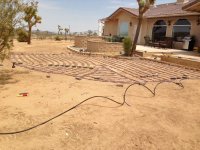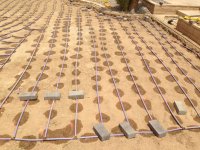orezok
Elite Member
Turf is something you rarely see around here. Because of weather conditions and high water prices, nobody has it. The only turf you see at schools is the football field. Baseball and all other schools play on dirt!
Anyway, my wife wanted a little patch of turf for the dog. She (the dog) likes to roll on the grass when we go camping and when she does it on our sandy soil, she gets completely covered with dirt.
The biggest drawbacks are the temperatures, the wind and the high cost of water. With normal irrigation, the wind blows 1/3 of the water away and the heat evaporates another 1/3 before the turf can get it.
I decided to give subterranean drip a try. The wind and heat will have little effect and I'm hoping to get by with less than half the water.
I'm using a Rainbird product that has .6 GPH emitters at 12" centers. The lines are placed 12" apart. The drip emitters have a small piece of copper in them that keeps the roots from growing in. I completed the first half and turned the water on to see how it would work. The pictures were takes after it had been on only a couple of minutes.
I will be putting 4" of top soil over the lines after I complete staking them in straight lines and spacing.
I don't know how well this will work, but I'm giving it a try.
Anyway, my wife wanted a little patch of turf for the dog. She (the dog) likes to roll on the grass when we go camping and when she does it on our sandy soil, she gets completely covered with dirt.
The biggest drawbacks are the temperatures, the wind and the high cost of water. With normal irrigation, the wind blows 1/3 of the water away and the heat evaporates another 1/3 before the turf can get it.
I decided to give subterranean drip a try. The wind and heat will have little effect and I'm hoping to get by with less than half the water.
I'm using a Rainbird product that has .6 GPH emitters at 12" centers. The lines are placed 12" apart. The drip emitters have a small piece of copper in them that keeps the roots from growing in. I completed the first half and turned the water on to see how it would work. The pictures were takes after it had been on only a couple of minutes.
I will be putting 4" of top soil over the lines after I complete staking them in straight lines and spacing.
I don't know how well this will work, but I'm giving it a try.

